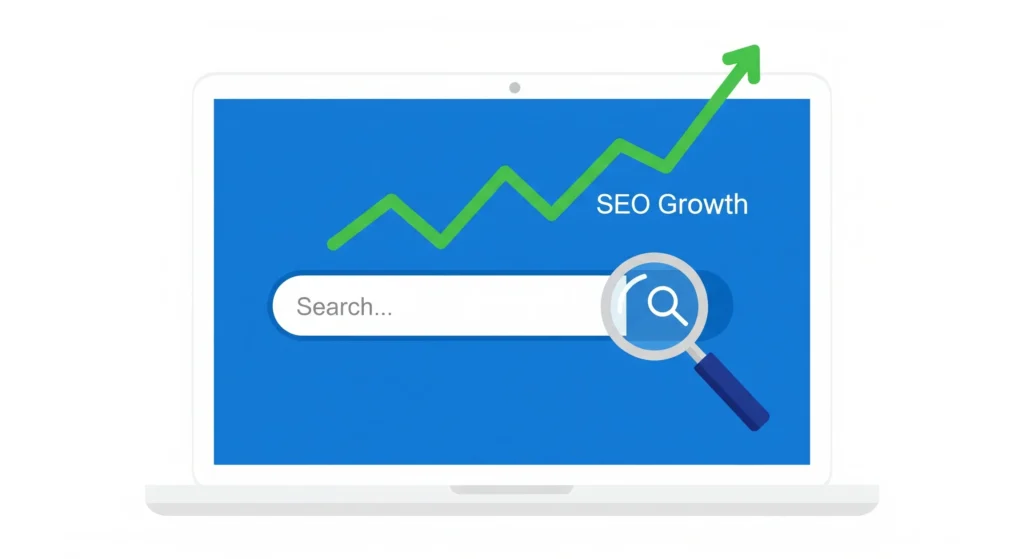If you’re trying to grow a website, there’s one thing you’ll hear again and again—SEO. More specifically, on-page SEO. It’s not the flashiest part of digital marketing, but it’s the backbone of why some websites show up on page one of Google and others don’t even make it to page five.
The funny part? A lot of people think SEO is about stuffing keywords everywhere. But the truth is, on-page SEO is more about clarity and relevance. It’s about making your page easy for both users and search engines to understand.
In this guide, we’ll dig into what on-page SEO actually means, why it matters, and how you can apply it step by step.
What is On-Page SEO?
Think of on-page SEO as everything you can directly control on your website to make it search-friendly. It’s like cleaning your house before inviting guests—you set things in order so visitors feel comfortable.
Google’s crawlers (bots that scan websites) are those “guests.” If they can’t understand what your page is about, or if the content feels messy, they’ll leave confused. And confused bots = poor rankings.
On-page SEO covers things like:
-
Optimizing titles and meta descriptions
-
Using proper headings (H1, H2, etc.)
-
Adding relevant keywords naturally
-
Improving page speed
-
Mobile-friendliness
-
Internal linking
-
Image optimization
-
Content depth and readability
Basically, it’s everything you do on the page itself, as opposed to off-page SEO (backlinks, PR, social signals).
Why Does On-Page SEO Matter?
Search engines are smart, but not perfect. They still rely on signals to figure out:
-
What your content is about
-
Whether it’s useful and trustworthy
-
Who it should be shown to
If you nail your on-page SEO, you’re telling Google clearly:
-
“This article is about X.”
-
“Here’s proof it’s valuable.”
-
“Here’s why it deserves to rank higher than the other 10 million pages about X.”
Without it, even the best content can get buried.
Core Elements of On-Page SEO
Let’s break down the important factors.
1. Title Tags
Your title tag is like the headline on a newspaper. It’s usually the first thing people see in search results.
Good practice:
-
Keep it under 60 characters.
-
Place the main keyword near the beginning.
-
Make it click-worthy but not clickbait.
For example, instead of:
“Learn About SEO and Ranking Factors for Websites 2025 Guide”
Try:
“On-Page SEO Guide 2025: Simple Steps to Rank Higher”
The second one is clear, keyword-focused, and appealing.
2. Meta Descriptions
Meta descriptions don’t directly affect rankings, but they affect click-through rate (CTR). Think of them as the ad copy for your page.
Best practices:
-
Keep it around 150–160 characters.
-
Include the target keyword.
-
Make it sound like a benefit, not just a summary.
Example:
“Learn practical on-page SEO strategies to rank higher in Google. Easy tips for titles, keywords, and content optimization.”
3. Headings (H1, H2, H3)
Headings help structure your content for readers and search engines.
-
H1: Should contain the primary keyword (one per page).
-
H2/H3: Subtopics that support your main theme.
A mistake people often make: using headings just for design. That’s not their role. Headings are signposts telling Google, “Hey, this section is about XYZ.”
4. Keywords and Search Intent
You’ve probably heard “keywords are everything.” The reality: keywords are important, but intent is king.
Example: If someone searches “best laptops under 50k,” their intent is buying, not learning. If you write a history of laptops, you’ll lose them.
Tips:
-
Research long-tail keywords (e.g., “on-page SEO checklist for beginners” instead of just “SEO”).
-
Sprinkle them naturally in headings, intro, and body.
-
Don’t force it. Write for people, optimize for Google.
5. URL Structure
Clean URLs are underrated.
Instead of:www.site.com/blog/2025/09/15/onpage-seo-complete-guide-article
Use:www.site.com/on-page-seo-guide
Short, keyword-rich, easy to read.
6. Internal Linking
Internal links guide both users and bots. They distribute authority across your site.
For example, if you’re writing about on-page SEO and you already have a blog about “keyword research,” link to it. That’s how you build a web of knowledge.
But don’t overdo it. Three to five meaningful links per 1,000 words is solid.
7. Content Quality and Depth
Google rewards content that actually answers questions. A 300-word fluff post won’t compete with a 1,500-word detailed guide.
But “long” doesn’t automatically mean “better.” Relevance matters.
Ask yourself:
-
Does my content fully cover the topic?
-
Would a beginner understand it?
-
Would an expert find value too?
8. Page Speed and Core Web Vitals
Nobody likes a slow site. Even a two-second delay can tank conversions.
-
Compress images.
-
Use caching.
-
Optimize your hosting.
Google uses Core Web Vitals (loading, interactivity, stability) as ranking factors. So yeah, speed matters more than ever.
9. Mobile Friendliness
Most searches happen on mobile now. If your site isn’t responsive, you’re basically telling half your audience to go away.
Use responsive design and test your site with Google’s Mobile-Friendly Test.
10. Image Optimization
Images can slow your site down if not handled properly.
-
Use descriptive file names (e.g.,
on-page-seo-checklist.png). -
Add alt text (helps accessibility + SEO).
-
Compress before uploading.
Bonus: Images can rank in Google Images, which brings extra traffic.
11. Schema Markup (Structured Data)
This is like giving Google extra context. Schema can help you show up with rich snippets (star ratings, FAQs, event times, etc.).
For example, a recipe page with schema might show cooking time and calorie info directly in search results.
Common Mistakes to Avoid
-
Keyword stuffing: Adding the same phrase everywhere is outdated.
-
Thin content: Writing 500 words on a huge topic just to “have a page.”
-
Ignoring search intent: Ranking means nothing if you don’t give users what they want.
-
Duplicate content: Don’t copy-paste. Google will catch it.
-
Not updating old posts: SEO isn’t one-and-done. Refresh content regularly.
On-Page SEO Checklist (Quick Recap)
-
Optimized title tag with main keyword.
-
Engaging meta description.
-
Proper H1, H2, H3 structure.
-
Keywords placed naturally.
-
Clean, short URLs.
-
Internal links to related pages.
-
Comprehensive, useful content.
-
Fast page loading.
-
Mobile responsiveness.
-
Optimized images.
-
Schema markup where relevant.
Final Thoughts
On-page SEO isn’t rocket science, but it does take consistency. It’s less about tricks and more about making your website clear, useful, and fast.
When you start applying these methods—title optimization, proper headings, internal links, fast loading times—you’ll notice search rankings improving over time. It won’t happen overnight, but it’s one of those compounding efforts: small tweaks today mean big traffic tomorrow.
So, instead of stressing about gaming the algorithm, focus on building pages that are valuable and well-structured. That’s the real heart of on-page SEO.



